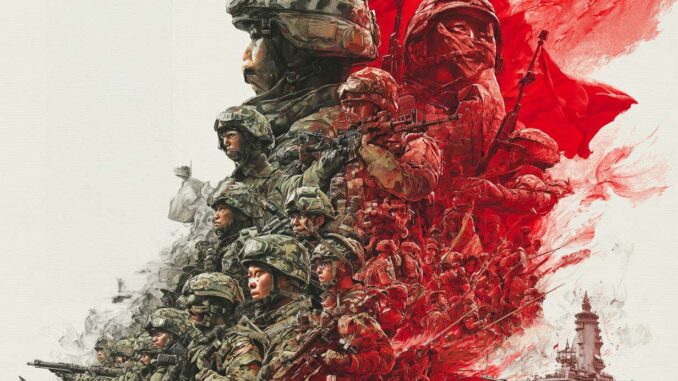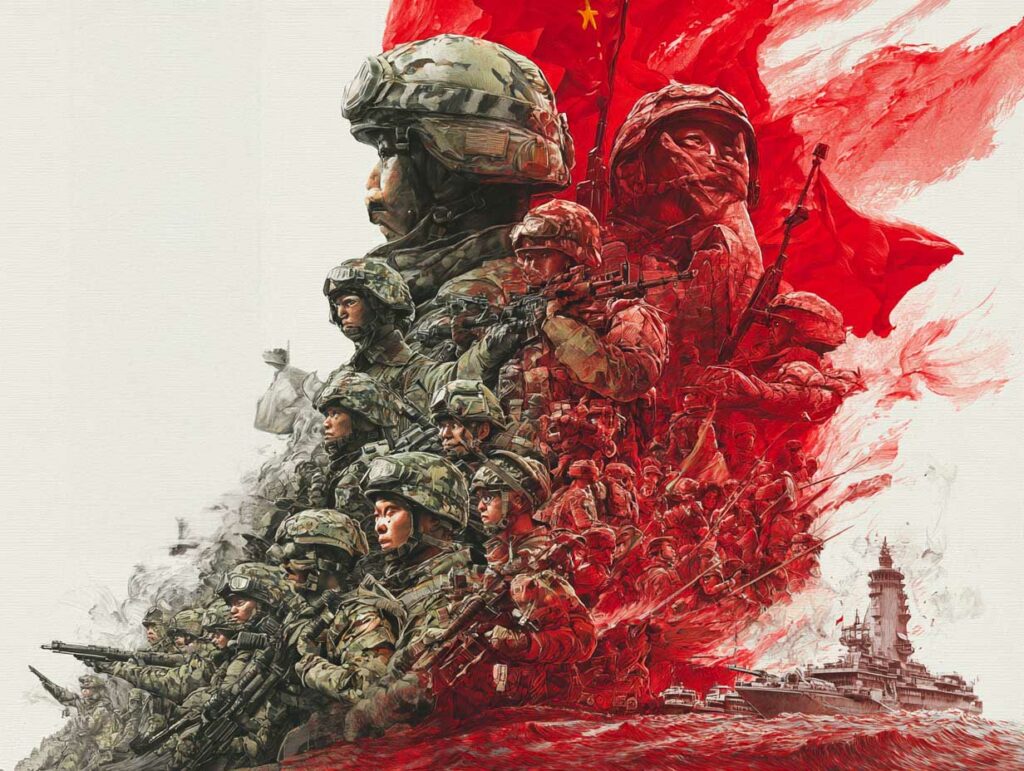
Analysis of China’s border tensions: origins of the conflicts, China’s view of the threats, and Beijing’s strategic objectives in Asia.
What Beijing considers to be the “sources” of tension
US military encirclement and regional coalitions
In the official Chinese narrative, the rise in friction is primarily caused by the expansion of US alliances (AUKUS, Quadrilateral/‘Quad’), increased US access to Philippine bases (EDC), and ‘freedom of navigation’ patrols that threaten its security environment. Beijing has condemned AUKUS since 2021 as a “Cold War” drift and a risk of proliferation, while Washington, Canberra, and London see it as protecting a “free and open” Indo-Pacific.
On the Philippine side, the EDCA has been expanded (nine sites in total, including four additional ones in 2023, notably north of Luzon and in Palawan), which Beijing interprets as logistical facilitation in the event of a crisis around Taiwan and in the South China Sea.
“Undefined” borders and “historic rights”
Beijing maintains that several land and maritime borders have never been legitimately settled: rejection of the McMahon Line in Arunachal Pradesh (renamed ‘Zangnan’ by China) and contestation of a demarcation “imposed by colonialism.” Chinese diplomats repeat that “Arunachal Pradesh” is illegal; New Delhi replies that the state is an integral part of India.
In the South China Sea, Beijing claims “historic rights” within a nine-dash line (which became a ten-dash line in 202, despite a 2016 ruling by an arbitration tribunal seized by Manila that found these claims contrary to UNCLOS. China rejects this ruling as “null and void.”
Separatism and “holistic” national security
For Beijing, Taiwan’s ‘secession’ (and “external interference”) are the main threats to territorial integrity. The Anti-Secession Law (200 codifies the possibility of “non-peaceful means” if certain red lines are crossed. In 2025, a white paper on national security further expanded the concept of security to encompass all aspects of politics, economics, and technology.
Where and how tensions are manifesting
South China Sea: “below the threshold” coercion
The legal framework Beijing has established for itself. China’s Coast Guard Law (2021) allows for the graduated use of force against “intrusions” into waters claimed by China. This law was supplemented in 2024 by Regulation No. 3, which remains deliberately vague on the conditions for its use, thereby maintaining ambiguity and the risk of miscalculation.
Gray zone instruments. In addition to the China Coast Guard (CCG), China makes extensive use of a maritime militia (armed/subsidized paramilitary vessels) to saturate reefs, block supplies, and deter without firing. The AMTI/CSIS documents record deployments in 2024-2025, with increasing professionalization of the Hainan units.
The Philippine front. 2023-2025 saw an acceleration of collisions, water cannoning, and floating barricades around Scarborough, Sabina, and Second Thomas Shoal. Manila opted for a strategy of transparency (dissemination of images, diplomatic coalition), while the CCG stepped up its “expulsion measures.” Incidents in 2024 (damage to Philippine ships) and 2025 near Scarborough confirm the escalatory trajectory. Legally, Manila is relying on the 2016 ruling.
The “ten-dash line” map. Published in August 2023, it adds a line east of Taiwan and reaffirms almost total control, triggering regional protests.
East China Sea: ADIZ and continued pressure around the Senkaku/Diaoyu Islands
In 2013, China proclaimed an ADIZ that overlaps those of Japan, Taiwan, and South Korea. Since then, the CCG’s presence in the contiguous zone of the Senkaku Islands has reached record levels: almost daily in 2024, with regular incursions into Japanese territorial waters. These patterns are closely monitored by Tokyo (JCG, MOF) and commented on by regional observatories.
Himalayas with India: latent militarization and “xiaokang villages”
After the Galwan clash in June 2020 (with deaths on both sides), the two armies created buffer zones but also densified roads, advanced bases and deployments. Beijing, which denies the validity of the McMahon line and reaffirms its “Zangnan” terminology, has simultaneously built dual-use “wellness villages” (civilian housing/military installations) along the LAC and into areas disputed with Bhutan, thereby creating a “fait accompli” on the ground.
Sino-Burmese border: stabilizing an unstable buffer zone
The civil war in Burma has destabilized China’s border districts (scams, smuggling, stray shells). Beijing has repeatedly sponsored ceasefires (January 2024 and January 2025 with the MNDA, with the explicit aim of preventing spillovers and reopening trade posts). These arrangements remain fragile, but illustrate China’s priority to “smother” peripheral crises.
Taiwan: calibrated military pressure and legal anchoring
The Anti-Secession Law (200) frames the doctrine; since 2022, air and naval patrols, blockade exercises, and crossings of the median line of the strait have intensified to “normalize” the PLA’s presence around the island. US Department of Defense reports set a PLA capability milestone for 2027 (without saying that an invasion has been decided) and continued modernization towards 2035/2049.

How Beijing justifies its actions (Chinese perspective)
- Correcting the “colonial legacy”: China presents its claims as the rectification of lines imposed when it was weak. The rejection of the McMahon Line and the standardization of place names to ‘Zangnan’ are part of this logic of cartographic and discursive “re-Sinicization.”
- Restoring strategic depth: in the ECS (ADIZ) as in the MCM (militarized reefs, armed coast guard, militia, Beijing wants to push enemy sensors and attrition as far as possible from its coastal centers of gravity. The CCG law and its regulations, coupled with the “three wars” (opinion, psychological, legal), provide a political and legal toolkit for this approach.
- Managing gray zones to avoid war: use of paramilitary units, water cannons, and quasi-permanent “patrols”; the idea is to wear down the adversary without crossing the lethal threshold—especially when facing a US ally (Philippines, Japan). The series of incidents in 2024-2025 around Scarborough/Sabina/Second Thomas and the record presence of the CCG near the Senkaku Islands are illustrations of this.
- Securing supply lines (the “Malacca dilemma”): the vulnerability of energy flows transiting through Malacca has been a feature of Chinese doctrine since Hu Jintao. Hence the BRI land corridors (CPEC to Gwadar, CMEC to Kyaukphyu and its oil and gas pipelines), which bypass maritime chokepoints.
- Preventing “interference” and “separatism”: in Myanmar, Beijing is seeking a stable buffer zone for its investments and to prevent unrest from spreading to Yunnan; in Taiwan, the aim is to impose PLA normality around the island, while maintaining the legal tool (ASL) and political and economic pressure.
The strategic objectives served by these tensions
Objective 1: Erode the margin for adverse action and break up coalitions
China is constantly testing the tolerance thresholds of its neighbors and the cohesion of coalitions aligned with Washington (AUKUS, Quad, US-Japan alliance, US-Philippines alliance). Each calibrated “incident” aims to force the adversary to choose between risky escalation and implicit acceptance of a new status quo. Constant activism also sends a signal that any foreign presence in its “adjacent waters” will come at a cost.
Objective 2: Build “de facto” control (fait accompli)
At sea, there is an increase in patrols, roadblocks, and blockades; on land, habitable “villages” with roads, administration, and telecommunications are scattered, sometimes in disputed locations (Bhutan). These actions are slowly but surely changing the operational environment and making any reversal more costly.
Objective 3: A2/AD and progressive “exclusion zones”
The military objective is to keep the US Navy and its allies at a distance from the first/second island chain in layers: anti-ship and anti-aircraft missiles, aviation, submarines, but also coast guards and militias for daily friction. The PLA’s ramp-up (with internal challenges, notably corruption, which is hampering certain capabilities) is in line with the 2027/2035/2049 milestones.
Objective 4: Secure supplies and access to the Indian Ocean
CPEC to Arabia and Africa via Gwadar, CMEC/oil pipelines via Kyaukphyu: these corridors reduce dependence on Malacca, diversify routes, and create bilateral economic dependencies that are useful to Chinese diplomacy.
Objective 5: Internal legitimacy and “holistic security”
Firmness at the borders feeds the Party’s legitimacy in its quest for “national rejuvenation.” The 2025 white paper illustrates the integration of territorial, economic, technological, and ideological security; border crisis management (Burma and the “legalization” of maritime practices (CCG law) are the result.
Operational translation, Chinese side
- Offensive legality (“lawfare”): publication of standard maps, toponymy (“Zangnan”), ADIZ, CCG law and its regulations; everything is used to claim the normality of Chinese actions.
- High-frequency gray zone: coast guard, militia, and state vessels (rather than frigates) to maximize pressure and minimize escalation. The Philippines and Japan are the main targets.
- Land “salami slicing”: civilian settlement and dual infrastructure near/beyond the LAC and along Bhutan to gradually shift the lines of fact.
- Management of peripheral “glacis”: arbitration/brokerage in Myanmar to contain the spread of violence and secure BRI corridors.
What this means for the coming years
- South China Sea: the standoff between Beijing and Manila will continue. China will keep up the “militia + CCG” pressure, while testing the strength of the US-Philippine alliance and the patience of the Europeans, who are beginning to patrol the area. The 2016 ruling will remain Manila’s legal compass, but Beijing will bet on attrition.
- East China Sea: The normalization of an almost daily CCG presence around the Senkaku Islands, under the ADIZ umbrella, aims to make Japanese exploitation of these waters “costly.” A serious incident cannot be ruled out, but the coast guard format should remain the preferred option.
- Himalayas: Patrols will continue to be governed by ad hoc protocols and buffer zones, but the density of infrastructure on both sides (with xiaokang villages on the Chinese side) is freezing a long-term standoff. The “Zangnan” rhetoric will continue to accompany symbolic gestures (renaming).
- Taiwan: Beijing will continue to normalize a PLA presence around the island and seek to deter/delay any allied coordination. The 2027 capability milestone will remain a marker; the decision to use force will depend on political, military, and economic cost/benefit calculations.
- BRI corridors and the Indian Ocean: The port and energy effort (Gwadar/Kyaukphyu) is strategic for loosening the grip on Malacca; it will continue despite security uncertainties.
In summary, China believes it is “under” external pressure (Western alliances and military presence) and that its historical “rights” are being challenged. It is responding with a mix of domestic law, cartography, coercion below the threshold and dual implantation to gradually shape a favorable security environment: strategic depth, diversified supply routes, de facto control of contested areas, and intact coercive options on Taiwan. For its neighbors, this means absorbing chronic pressure, managing the risk of incidents, and deciding how much they are willing to “pay” to challenge this strategy of attrition on a daily basis.
War Wings Daily is an independant magazine.